By JIN Chichuan
Editor’s Note:
The Einstein Probe (EP) is an international mission initiated and led by the Chinese Academy of Sciences (CAS) to observe high-energy transients, a type of astronomical objects whose temporal dynamics helps us understand the evolution of the universe and some fundamental questions in basic physics. Expected to fly at the end of 2022, it will close a long-existing gap in X-ray astronomy. Dr. JIN Chichuan, a researcher of the EP team has the story.
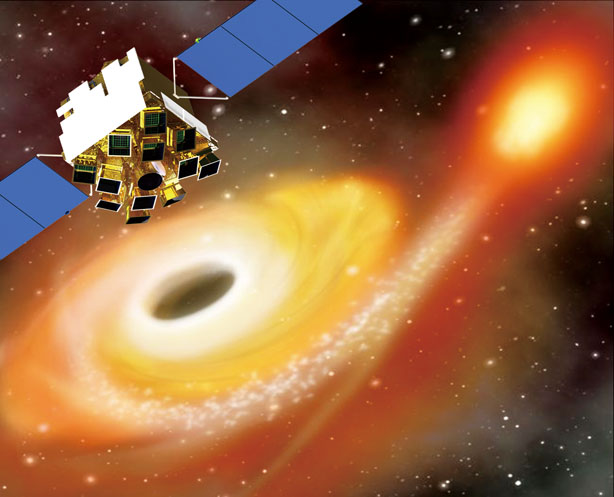
The conceptual design of the EP satellite. (Image designed by Yuan Miao based on the illustration of EP satellite by courtesy of EP team and that of the tidal disruption event by NASA)
Unknown X-rays from the Universe
On June 18th, 1962, in the famous desert of White Sands in New Mexico, United States, a few tents and equipment were scattered and a small rocket was erected not far away. At the time, the setting sun sprinkled its last rays over the desert, coating it with a rosy tone, but the busy people had no time to appreciate the beauty.
Leader of these camping people was Prof. Riccardo Giacconi, a scientist working for the American Science and Engineering Inc. at that time. This team planned to launch a small sounding scientific rocket, in the hope to observe the X-rays produced by the lunar surface due to its interaction with the solar wind particles.
X-rays make an important part of the electromagnetic spectrum, which were firstly discovered by Prof. Wilhelm Conrad Roentgen in 1895. X-ray photons have higher energy than other wavebands such as ultraviolet, optical, infrared and radio, and they may be produced in some extreme conditions. In the mid-20th century, scientists predicted that the Sun and the Moon should most likely produce strong X-ray radiation based on previous radio and optical observations. However, because of the absorption by atmospheric gases, the X-rays cannot be effectively detected from near the ground. Before the experiments of Giacconi’s team, several teams had already tried to detect X-ray radiation from celestial bodies other than the Sun, but they all failed.
To pick up the X-ray radiation, Giacconi’s team had also launched sounding rockets before, but they were a little unlucky as no data were recorded due to the instrument failure. This time, they must check more carefully. To improve the capability of the instruments and to ensure the reliability of the system, Giacconi’s team also made significant improvements in the sensitivity of the detector – the Geiger counter, and installed three detectors on the rocket. If theoretical predictions were correct, this would be the first time for human beings to see the Moon in X-rays.

A view of the twilight in the White Sands Desert in New Mexico, USA. (Credit: Mark Betts/Flickr)
The rocket was successfully launched. It reached a height of more than 200 kilometers, and fell back to the ground after a short flight of 350 seconds at high altitude. According to the rocket wreck found the next day, the observations were generally successful, and two of the three Geiger counters worked properly. The subsequent data analysis found that the entire process lasted for more than 300 seconds. However, Giacconi’s team was disappointed that X-rays from the direction of the Moon were not detected. Unexpectedly, an unusually bright X-ray signal was detected in another direction. This signal was located in the direction of the constellation Scorpio, and was therefore named Sco X-1. In order to confirm that this signal was not a false one, the team spent three months in ruling out other possibilities, to finally confirm that this was indeed an unknown cosmic X-ray source. After they announced the results, many scientists were excited about it, because they knew that a new window to observe the universe had opened.
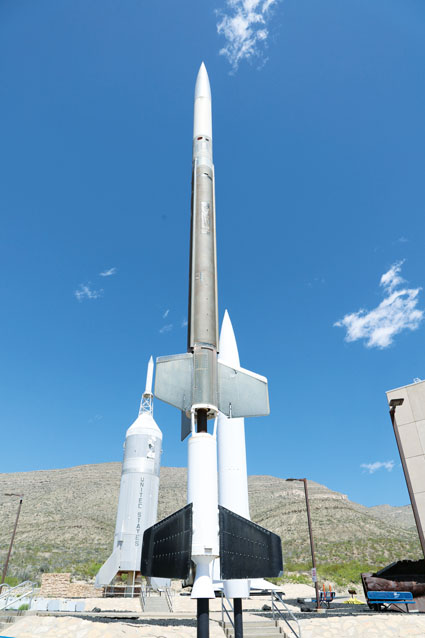
The Aerobee 150 sounding rocket used by Prof. Garconni to launch their three X-ray detectors in the desert of White Sands in 1962. (Credit: Ray Cunningham/Flickr)
Dawning X-ray Astronomy
Since then, scientists have been working on more advanced space telescopes, which can allow for longer observations outside the Earth atmosphere. X-ray astronomy has also greatly developed as a consequence. Up to now, dozens of X-ray instruments have been put into space, such as the famous Chandra X-ray satellite from NASA, the XMM-Newton satellite from ESA and the Insight-HXMT satellite from China. X-ray telescopes are getting more and more powerful in seeing very faint celestial objects, and producing more and more valuable scientific data. Nowadays the research frontier of X-ray astronomy is gradually changing from the study of morphology and spectral properties of individual sources to the study of the evolution of sources over time, i.e. the so-called “time-domain astronomy.”
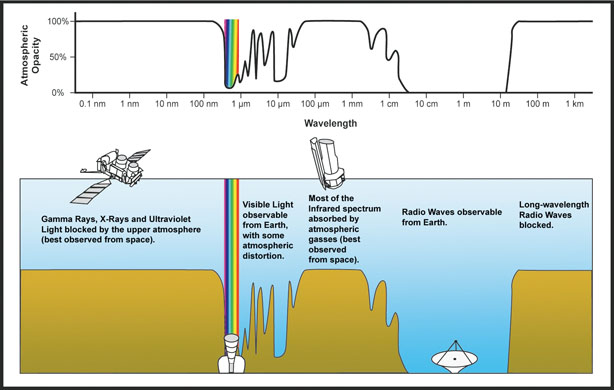
Due to the absorption by the Earth atmosphere in different wavebands, X-rays from celestial sources can only be observed outside the atmosphere in space. (Credit: NASA)
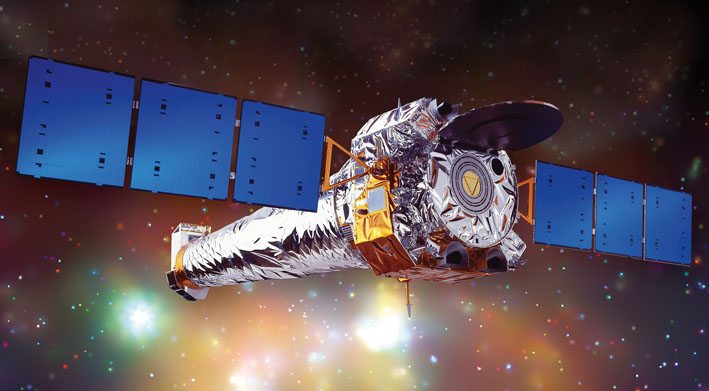
The image of Chandra observatory launched by NASA. (Credit: NASA/CXC/NGST)
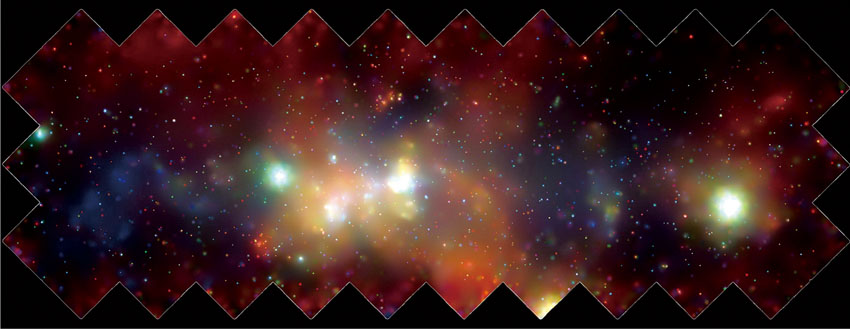
The X-ray view of the center of our Milky Way by the Chandra observatory. (Credit: NASA/UMass/D. Wang et al.)
New Frontier: Time-domain Astronomy
The main focus of time-domain astronomy is laid on the variability of celestial objects, especially a variety of transients and sources exhibiting violent outbursts. These are spectacular and mysterious natural phenomena in the universe, which are still rarely explored and poorly understood.
A transient is a celestial source that appears in a sudden, and then faints away, and eventually disappears. A violent outburst refers to a celestial source whose brightness rises by orders of magnitude in a short period of time. The origins of these phenomena can be roughly divided into two classes. One is related to the sudden change of the source itself, such as the collapse of stars, the merging of black holes and neutron stars. Famous examples include supernovae and gamma-ray bursts. The other is related to extreme physical environments, such as the strong gravitational fields and magnetic fields around neutron stars and black holes. Famous examples include X-ray binaries, active galactic nuclei, and black hole tidal disruption events. These short-duration astronomical events are difficult to predict in time and space. Therefore, in order to capture their signals timely, it is necessary to use telescopes that can observe a large area of sky simultaneously (i.e. large field-of-view), and can observe the same area of the sky very frequently for a long time (i.e. long-term monitoring with a high cadence).

The X-ray view of the center of our Milky Way by the Chandra observatory. (Credit: NASA/UMass/D. Wang et al.)
The window of X-ray observation plays a crucial role in time-domain astronomy, because transients and sources exhibiting violent outbursts are generally emitting X-rays. This high-energy waveband contains abundant information about the physical processes directly related to these extreme phenomena.
The current instruments flying in space that can perform X-ray all-sky monitoring with a large field-of-view include the BAT instrument carried by the Swift satellite from NASA, and the MAXI instrument from JAXA deployed on the International Space Station. These two instruments, along with the ASM instrument onboard the previous RXTE satellites from NASA, all operate in the medium and hard X-ray bands where X-ray photons have energies above 2 keV (1 keV = 1.602×10?16 J), while in the soft X-ray band below 2 keV there is yet no instruments to perform all-sky monitoring.
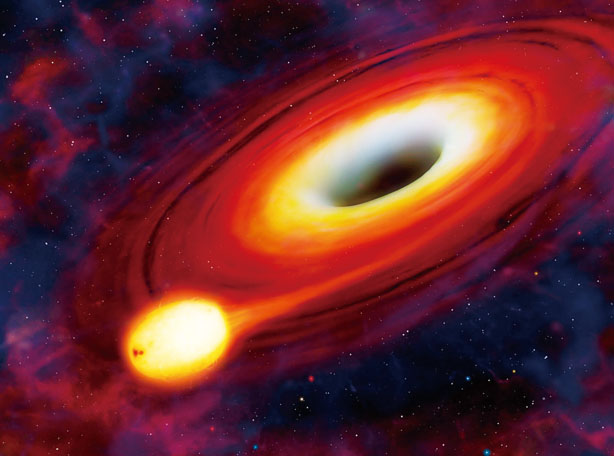
An artist drawing of a star being tidally disrupted by a black hole. (Credit: University of Warwick/Mark Garlick)
The main reasons behind the shortage of such instruments can be summarized in two aspects. On the one hand, all the X-ray all-sky monitors currently in use have adopted the design of non-focusing optics. But due to the constraints on weight and cost, this type of monitor has almost reached the technical threshold. On the other hand, the classic Wolter-I type X-ray focusing optics, which is currently widely used in building X-ray telescopes, can bring very high sensitivity and spatial resolution (such as Chandra and XMM-Newton satellites). But instruments based on this optical design have relatively small field-of-views, so they cannot work as all-sky monitors. Therefore, the design of future X-ray all-sky monitors needs to take a new approach.
A Powerful Instrument: Einstein Probe
As early as 1979, astronomer Dr. Roger Angel proposed a design of X-ray optics that mimics the imaging principle of the eyes of lobster, which could achieve a very wide field-of-view. In the past decade, this X-ray focusing optics technology for wide-angle imaging, the so-called lobster-eye micro-pore optics (MPO) technology, has matured, which makes possible the large-field observation with X-ray focusing imaging.
Since 2010, the National Astronomical Observatories (NAOC) of the Chinese Academy of Sciences (CAS) has engaged in the research and development of the MPO system, and now has mastered its principle and application technology. In this context, NAOC, together with the CAS Institute of High Energy Physics and some other institutions, proposed the concept of EP mission in response to the 2nd call for proposals for the Space Science Program of Chinese Academy of Sciences in early 2013.
EP is an astronomical exploration satellite dedicated to time-domain astronomy and high-energy astrophysics. It will be equipped with a wide-field X-ray telescope (WXT), which can meet the urgent scientific demands to perform all-sky monitoring in the soft X-ray band. WXT adopts the bionic lobster-eye focusing optics, which can achieve both a large field-of-view and high sensitivity. In addition, EP will carry a classic Wolter-I type X-ray telescope (FXT) in order to perform deep follow-up observations.
The mission’s name “Einstein Probe” bears special meanings. Firstly, the word ‘Probe’ symbolizes that the satellite can sharply capture astronomical phenomena such as tidal disruption events, electromagnetic counterparts of gravitational wave events and neutrino events. The data from EP will help scientists to answer fundamental questions such as the formation of black holes and the evolution of the universe. Secondly, since black holes and gravitational wave events are important predictions of Einstein’s theory of general relativity, putting the word “Einstein” in the name of the mission not only highly summarizes the major scientific goals, but also pays tribute to Prof. Albert Einstein – one of the greatest scientists in human history.
After more than two years’ hard work, the study of EP mission concept, scientific goals and key technologies and the development of core principle prototypes were completed. At the end of 2017, the EP mission was formally approved by the Chinese Academy of Sciences. The engineering development phase has begun since September 2017 with a development cycle of 5 years.
In the meantime, there are also proposals for the development of the soft X-ray all-day monitors using the same MPO technology in the world. For instance, in 2017 two mission concepts, including the ISS-TAO instrument proposed to be deployed on the International Space Station (planned for launch in 2022) and the Transient Astrophysics Probe (planned for launch in the late 2020s) were submitted to NASA for Phase-A mission concept study. In 2018, a mission concept called THESEUS was selected as one of the three finalists to compete for the ESA M5 mission of the Cosmic Vision Programme (planned for launch in 2032). Since none of these missions have been finally selected for construction and launch, China is currently in a leading position in this field.

The micro-pore optics adopted by EP/WXT to realize X-ray focusing imaging with a large field-of-view. (Credit: NAOC)
As mentioned above, the EP satellite will carry two telescopes: WXT and FXT. WXT will use the lobster-eye MPO system with a large field-of-view of ~3,600 square degrees, covering the soft X-ray energy band of 0.5–4 keV. Compared to the current X-ray monitors including Swift/BAT and MAXI, the detection sensitivity of the EP/WXT will be more than one order of magnitude higher. Because of its high sensitivity and real-time all-sky monitoring capability, EP would satisfy the strong scientific demand for monitoring the dynamic sky in the soft X-ray band. It could allow scientists to systematically discover X-ray transients in the universe such as tidal disruption events from otherwise quiescent black holes, and to monitor their subsequent activities. EP could also discover the electromagnetic counterparts of Gravitational wave events, thereby deepening our understanding of the merging processes of compact objects such as neutron stars and black holes. Therefore, the scientific outcomes and influence of the EP mission could be very significant.
The exploration of the universe in the X-ray band began in the 1960s. At the same time, the Japanese Shinkansen railway system came into operation. This marked the world’s first high-speed railway with a speed of nearly 300 kilometers per hour. In contrast, China’s development in the high-speed railway system was relatively slow at that time. Until the late 1990s, China realized the importance of high-speed railway system and began to develop it. Since the first official operation in 2008, China’s high-speed railway system has kept a high-speed development, to become one of the most magnificent human transportation systems in the world today.
Now the development of China’s X-ray astronomy is undergoing a similar process. In June 2017, 48 years after the launch of the world’s first X-ray satellite Uhuru, China launched its own first X-ray satellite Insight-HXMT from the Jiuquan Satellite Launching Center. A few years from now, we will witness the launch of the EP satellite and other X-ray instruments. Among them, there will also be flagship large observatories like eXTP. These space telescopes will adopt state-of-the-art technologies. Their operations will provide a vast amount of data of extremely high scientific values for the scientific community worldwide to improve their researches in astronomy and astrophysics, thereby greatly increasing the knowledge about the mysterious universe for all mankind. We look forward to these great prospects!

